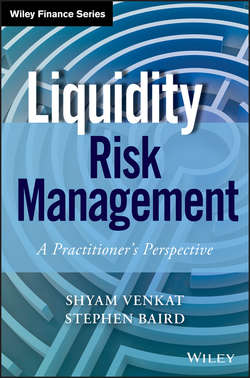Liquidity Risk Management

Реклама. ООО «ЛитРес», ИНН: 7719571260.
Оглавление
Baird Stephen. Liquidity Risk Management
Chapter 1. Introduction
A Practitioner's Perspective
Outline of the Book
Core Themes
Acknowledgments
Part One. Measuring and Managing Liquidity Risk
Chapter 2. A New Era of Liquidity Risk Management
Introduction
Governance and Organization
Measuring and Managing Liquidity Risk
Optimizing Business Practices
Further Considerations for the Path Forward
Chapter 3. Liquidity Stress Testing
Measuring Contingent Liquidity Requirements
Overview of the Model
Design of the Model
Testing Techniques
Baseline Scenario
Scenario Development
Development of Assumptions
Outputs of the Model
Governance and Controls
Liquidity Optimization
Funding Optimization
Establishing a Sustainable Infrastructure
Integration of Liquidity Stress Testing with Related Risk Models
Conclusion
Chapter 4. Intraday Liquidity Risk Management
Introduction
Uses and Sources of Intraday Liquidity
Risk Management, Measurement and Monitoring Tools for Financial Institutions
Risk Management, Measurement, Monitoring Tools for FMUs
Conclusion
Chapter 5. The Convergence of Collateral and Liquidity
A Word on Collateral and Collateral Management
Capital Markets Before 2008
Capital Markets Post-2008
The Case for Action
The Sell-Side
The Buy-Side
On Collateral Optimization
Improved Liquidity and Increased Collateral Efficiency: A Case Study
Conclusion
References
Chapter 6. Early Warning Indicators
Early Warning Indicators: Mechanism to Signal Upcoming Liquidity Crisis
Conclusion
Chapter 7. Contingency Funding Planning
Actions in a Liquidity Crisis
Evolving Capabilities and Enhancements
Design Considerations
Framework and Building Blocks
Additional Considerations
Conclusion
References
Chapter 8. Liquidity Risk Management Information Systems
Liquidity Risk MIS Reference Architecture
Liquidity Data Governance and Quality Control Framework
Design and Implementation Consideration
Conclusion
Chapter 9. Recovery and Resolution Planning – Liquidity
Liquidity Requirements in Recovery Planning
Liquidity Requirements in Resolution Planning
Conclusion
Part Two. The Regulatory Environment of Liquidity Risk Supervision
Chapter 10. Supervisory Perspectives on Liquidity Risk Management
Introduction
Rating Liquidity Risk Management with U.S. Banking Regulators' Rating System
Foundations Established in BCBS' “Sound Practices for Managing Liquidity in Banking Organizations”
Strategy Setting and the Oversight Role of Directors and Senior Management
Foreign Currency Liquidity Management
Core Internal Controls for Liquidity Risk Management
The Discipline of Public Disclosure
Monitoring Adherence to BCBS Standards
Conclusion
Chapter 11. LCR, NSFR, and Their Challenges
Introduction
Liquidity Coverage Ratio
NSFR
Qualitative Requirements and Monitoring Tools
Tackling the Practical Implementation Challenges
Part Three. Optimizing Business Practices
Chapter 12. Strategic and Tactical Implications of the New Requirements
Introduction
Strategic Impact of the New Ratios
Strategies for Optimizing Business Mix and Balance Sheets
Conclusion
Chapter 13. Funds Transfer Pricing and the Basel III Framework
Overview of Funds Transfer Pricing Objectives and Approaches
Capturing Volatility
A New Focus on Liquidity Risk and FTP
Approaches for Integrating Contingent Liquidity Costs and FTP
Some Practical Considerations
Conclusion
Chapter 14. Liquidity and Funding Disclosures
The Bank View
The Investor View
Leading Practices for Liquidity and Funding Disclosure
Conclusion
Biographies
Shyam Venkat
Stephen Baird
PwC U.S. Financial Services Advisory
PwC's UK Financial Services Risk and Regulatory Practice
WILEY END USER LICENSE AGREEMENT
Отрывок из книги
Liquidity Risk
A Practitioner's Perspective
.....
Leading institutions select and calibrate EWIs and related thresholds to transmit meaningful signals to management about the need for corrective action in light of changes in the broader business environment or impending potential firm-specific distress. Once a EWI registers a change in status, a robust and well-established escalation process will help ensure that management (and potentially the board) reviews the trends to better understand the cause, identify the potential impacts of evolving business dynamics, and take appropriate actions. The firm's selection of EWIs and their calibration should be reviewed to reflect any changes to business mix and activities and the changing nature of the macroeconomic and market environments.
EWIs should be forward-looking, selected so as to provide a mix of business-as-usual (BAU) and stressed environment information, and assessed against limits at predetermined intervals (e.g., daily, weekly, monthly). Continued deterioration in a single or combined set of EWIs should trigger the firm's emergency response tools, such as the contingency funding plan.
.....